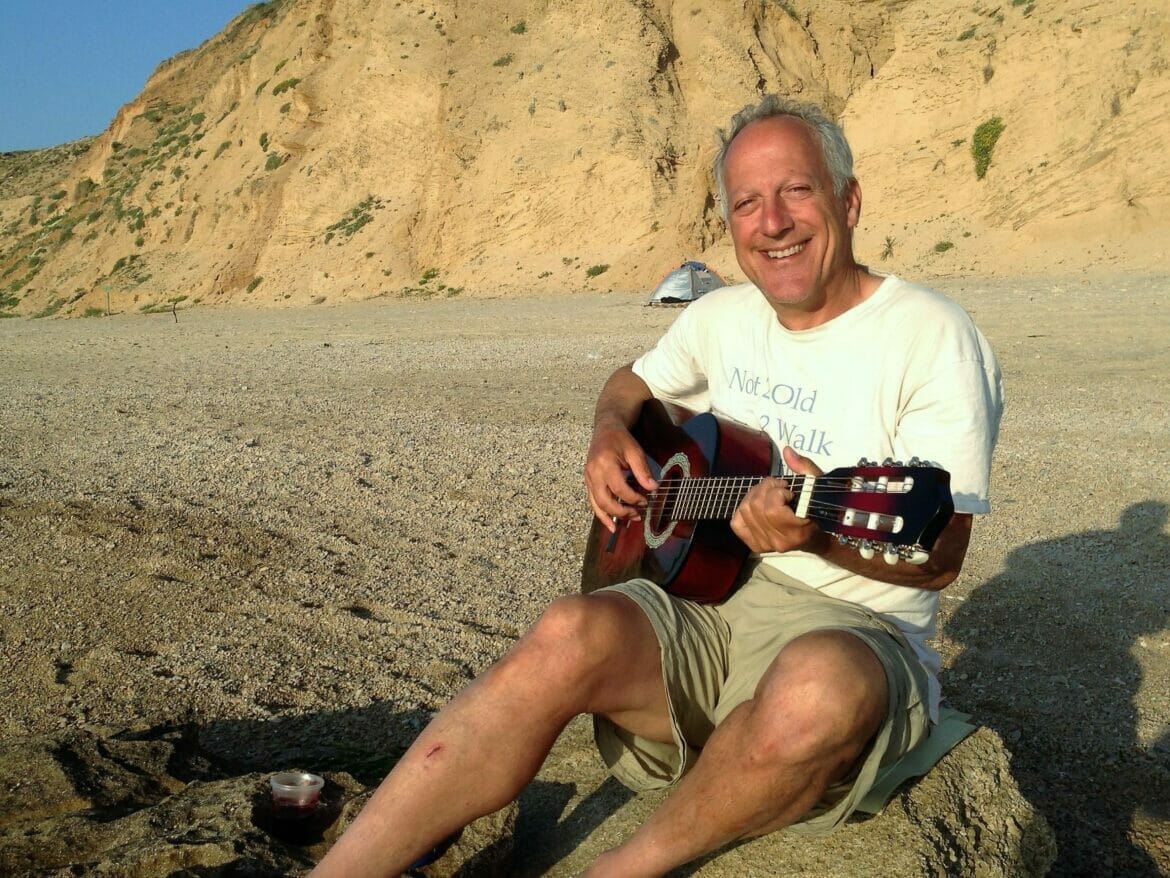
The Israel Trail. It’s been dubbed one of the world’s top 20 “Epic Hikes” by National Geographic. At around 1000 kilometers long, this trail winds from the greener pastures of the Galil down through the Negev. So many of us (myself included) can only dream of spending the eight to ten weeks it takes to complete this incredible journey.
Aryeh Green, an Oleh and Beit Shemesh resident, not only found the time to hike it at age 51, but also wrote a beautiful memoir detailing the life changing experience of trekking the Israel Trail. His book, My Israel Trail: Finding Peace in the Promised Land, is an engaging tale of physical and emotional struggle. Reading about his journey prompted me to find out more.

Here’s what Aryeh has to say about the experience of hiking the trail and writing his book:
Susannah: So many people ask me how I find the time to hike. It’s an easy question for me to answer- I love being outdoors and I love seeing beautiful things, so I constantly squeeze time into my schedule to go hiking. But even I can’t imagine fitting in the eight weeks it takes to hike the Israel Trail. What’s your secret?
Aryeh Green: On the one hand, I had just been divorced, and had a pressing need to get away, to be on my own, to re-evaluate – so it wasn’t a choice so much as a necessity. But on the other hand, as the head of a non-profit project which allowed for little time off, I had weeks of unused vacation coming me, and a very supportive board which enabled me to take the rest of the time as unpaid leave. And I had recently hired – with this in mind, among other things – an incredibly talented ‘2nd in command’ as it were, to run things while I disappeared for a few months.
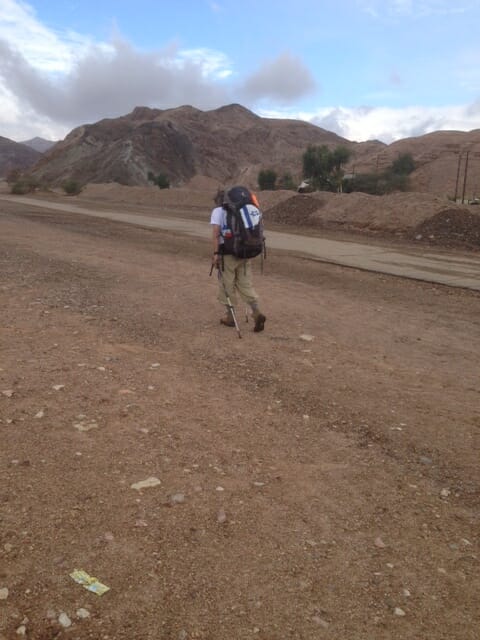
Susannah: You mentioned in your book that you didn’t have a favorite part of the trail – they were all just different. But are there one or two sections you could recommend for someone looking to hike just part of the trail?
Aryeh: Absolutely! I’d suggest three options, depending on a person’s interests (and could easily recommend dozens more!). First, the initial three days out of Eilat, in the southern Negev and Eilat mountains, are phenomenal, and very different from what most hikers encounter. From the physical challenges of steep ascents and descents, to the eerie but stirring silences of the desert, from the emptiness of the rocky mountains to the multiple colors of those hills, it’s a wonderful, and unique, experience.
“From the physical challenges of steep ascents and descents, to the eerie but stirring silences of the desert, from the emptiness of the rocky mountains to the multiple colors of those hills…”
Second, I found the hills of the upper Galil, from Gesher Alma to Mt. Meron, Tzfat, and along Nachal Amud down to the Kinneret, surprisingly refreshing – and surprisingly untraveled. I was alone much of the time, in forests which reminded me of northern California, stumbling on small jewels of springs, valleys, creeks and forests, as well as historical elements, which made for an incredibly enjoyable, and uplifting, few days.
Last, I’d highly recommend the few days along the coast around Tel Aviv. Really! Most people ‘do’ the usual Tel Aviv haunts; but the Trail winds from Netanya via ancient ruins and Herzliya beach to the Tel Aviv port, and from there inland along the Yarkon river – and you’d be amazed that 40 minutes from the bustle of Tel Aviv’s equivalent of NY’s Central Park (smaller/narrower but you get the idea) you find yourself meandering along a small river surrounded by brush and trees, birds and small animals, all alone. And then you end at the Sources of the Yarkon park, where you’re met by not only a lovely water-based national park but a fortress thousands of years old, reminding you that you’re not in Kansas….
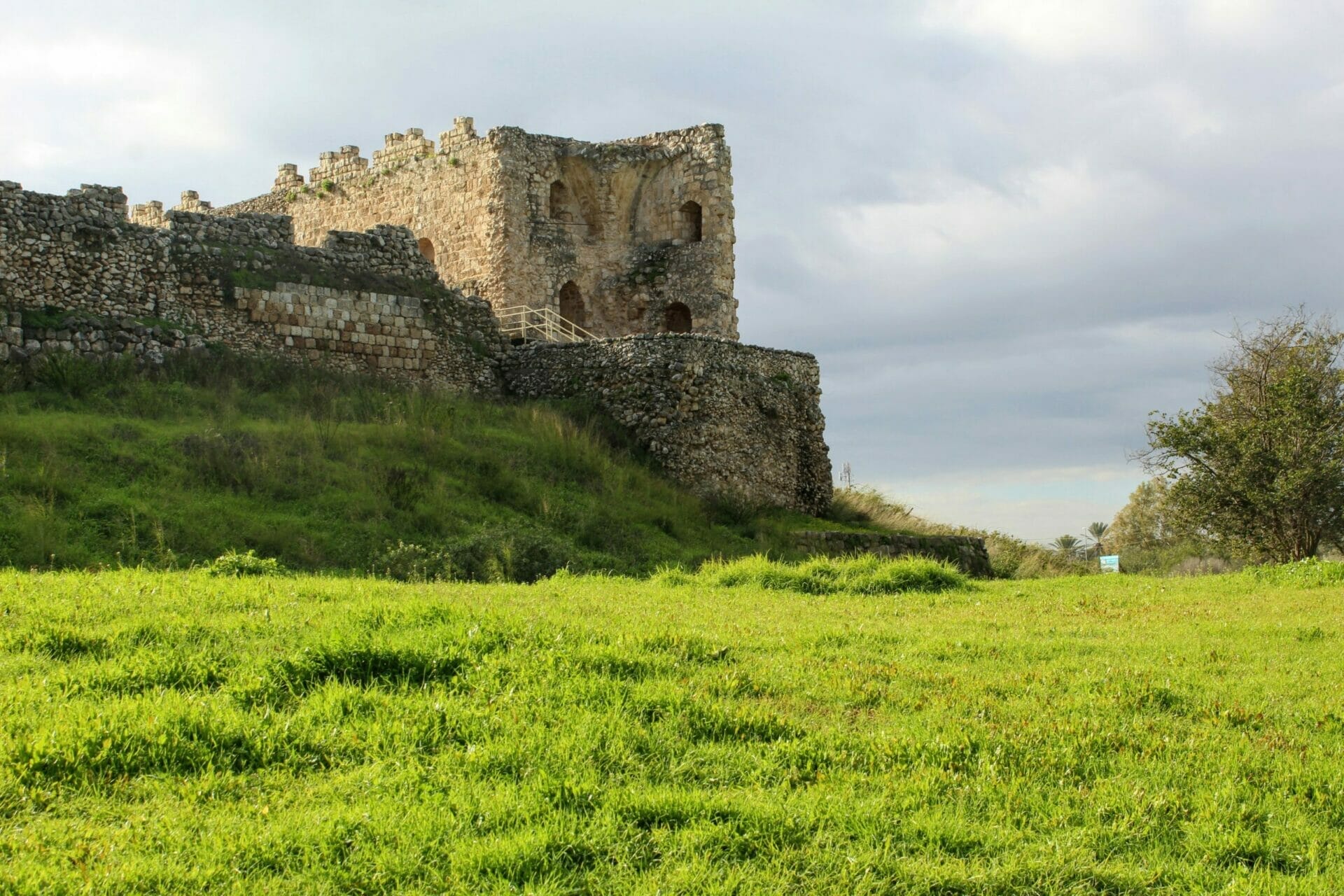
Susannah: Yes! The ancient ruins in some of the most unexpected places really make hiking in Israel a unique experience.
Most people know that it takes a tremendous physical effort to make it through a 1000 kilometer hike. What are some unexpected challenges you dealt with along the way?
Aryeh: Truth is, every day presented a new challenge of sorts, whether just waking up and getting started, or the heat and loneliness, or as you note the physical difficulty of the hike, the pack, the rocks and the like. One unexpected challenge was the steepness of some of the ascents: you don’t really recognize the parameters listed on maps and guides until you start climbing up a vertical rise, hand over hand, across boulders twice your size, wearing your 50 Lb pack… and then you realize you’d better pay more attention to the map coordinates.
Another challenge was the dangerous cliff-sides along which the Trail occasionally winds. I had to remind myself sometimes, on paths about a foot wide on the side of a mountain, a drop to the rocks 30 feet below just a misstep away, that others passed this way before me, even with heavy backpacks on, and that schoolkids do these trails annually! (Whether they should be allowed to is another discussion….)
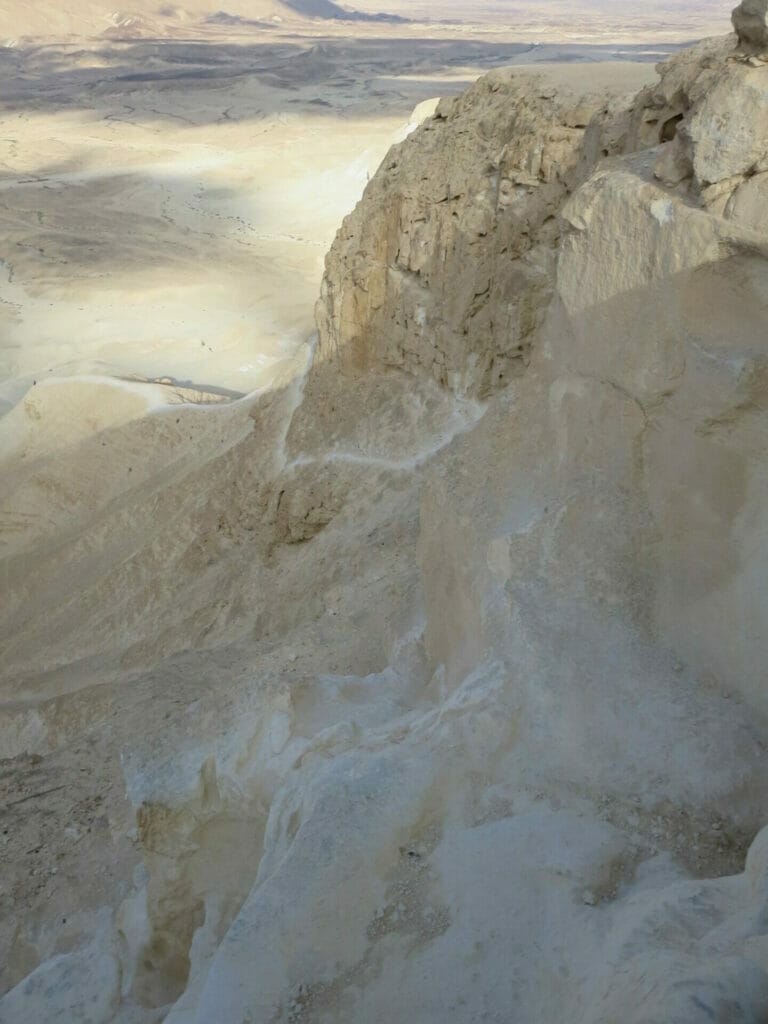
A final challenge, not unrelated to the loneliness, was trying to balance my need for solitude with my desire for companionship and for connection with family and friends. I occasionally walked with others I found on the Shvil, but found that both distracting and irritating. I managed, after the first week or two of desert aloneness, to create something of a routine where I’d message or call my kids every few days, or a close friend, but otherwise remained out of touch most of the time.

Susannah: In your book, you spoke about the life lessons you learned while on the trail. Could you give our readers a short summary of some of the mental changes you went through while hiking the Israel Trail?
Aryeh: I can, but I hesitate to, as the ‘short version’ removes so much of the value and significance of those lessons. 😊 At base, I discovered a new sense of humility, and gratitude, as well as an acceptance of my lot, as it were. In addition, I reached a level of forgiveness which I hadn’t otherwise experienced, and all this enabled me to focus on the future, looking forward and setting goals giving my life a sense of meaning and purpose. As I note in the book, it’s not that any of these five elements are particularly innovative; it’s the process I went through, and a unique way of combining them, which helped me meet my personal challenges (and may help others as well).

Susannah: Many see Israel as a tough place. From my perspective, our country has an incredible diversity of climate and topography that makes it one of the most interesting places to hike. What’s your take after hiking the entire length of the country?
Aryeh: Agreed! With forests and lakes in the north, deserts in the south, sea to the west and mountains to the east, Israel is like a miniature California! It’s certainly one of the few places you can ski in the morning (in the Golan) and swim in the sea in the afternoon (in the Red Sea) – something I’ve personally done. And hiking through it gives a similar feeling: I remember the one day I walked through the transition from desert hills in the northern Negev to the woods of the southern Judean mountains, from drab grey and brown dirt and rocks to green and yellow trees and multi-colored flowers.
“It’s certainly one of the few places you can ski in the morning (in the Golan) and swim in the sea in the afternoon (in the Red Sea). “
Susannah: How does Israel’s history make hiking 1000 kilometers through the country different than traversing 1000 kilometers somewhere else?
Aryeh: Something I always note – having hiked in Yosemite, for instance, in the US, and the Lakes and Peak districts in the UK, and the Swiss Alps too – is that there is beauty and nature around the world, but there is only one place we can walk, as Jews, where every footfall is literally in the footsteps of our forefathers, in the land of our people. It’s only in our ancestral homeland that we walk along the paths tread by King David and Devorah the Prophet, Rabbi Akiva and so many others. And it’s only here that we stumble upon – as I did one day near the Baram Forest – the tomb of Isaiah the Prophet. Yes, that Isaiah, swords and plowshares and all: simply resting under a bower of trees alongside a bubbling brook, almost unmarked. Aside from the physical beauty, and the truly wonderful people you meet, that’s what makes hiking the Israel Trail remarkable – not only for a Jew, but especially so.
“It’s only in our ancestral homeland that we walk along the paths tread by King David and Devorah the Prophet, Rabbi Akiva and so many others. “
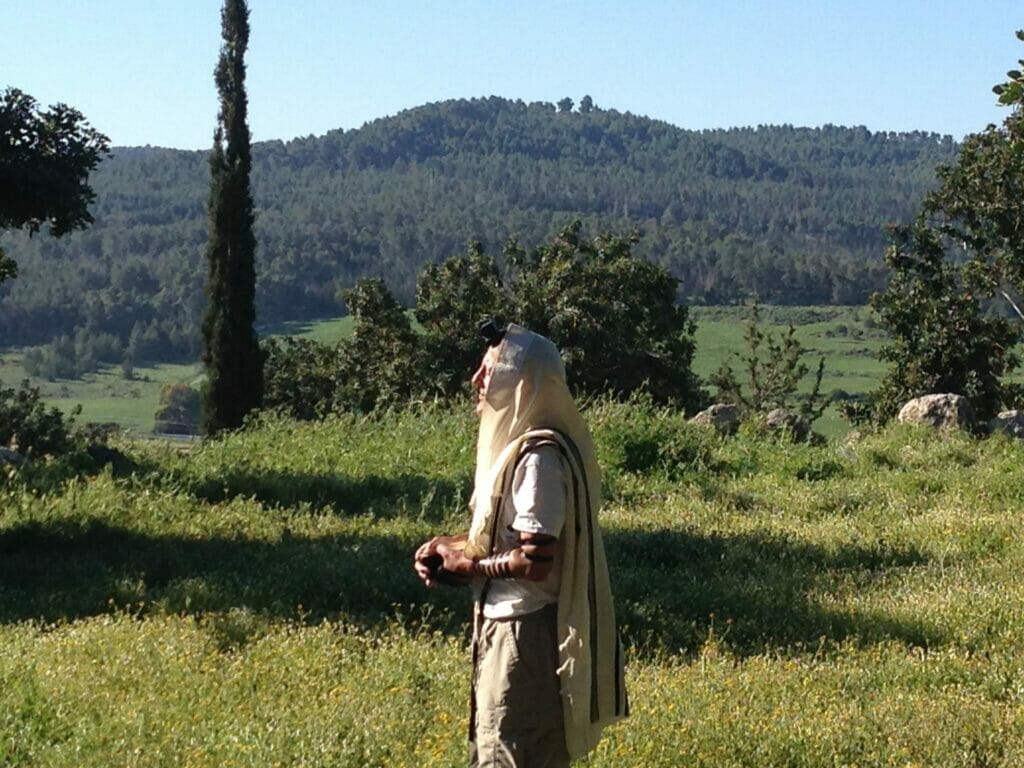
Susannah: So true. Now that you’ve completed the Israel Trail, what’s your next outdoor adventure? Do you still find time to fit spending time in nature into your busy life as a businessman, husband, father, and grandfather?
Aryeh: I still hike occasionally, but not as much as I’d like to; as you note, I’m pretty busy (with all those goals I set for myself at the end of my journey on the Trail). I get out on my bike in the Jerusalem foothills around Beit Shemesh at least once or twice a week, often with a friend or two, and that keeps me connected to nature (and to the Trail, as well). My ‘next adventure’ is to hike the Shvil again, including the many new additions and adjustments made in the past five years – this time with my wife, Miriam, as my partner (though she’ll decline to do the few dangerous parts).
Susannah: Why do you feel it’s important for the average Israeli to spend time hiking/outdoors?
Aryeh: As someone who studied psychology, and who loves nature, and who enjoys meditation, I can only say it’s not important: it’s imperative, and not just for Israelis! 😊 But I do feel it’s a crucial part of our connection to our land, to actually feel it beneath our feet, not only in a car or from a plane; and the pace of walking affords not only time for contemplation, and stillness, but an appreciation for the history as well as the small splendors, like the flowers and birds and the like.
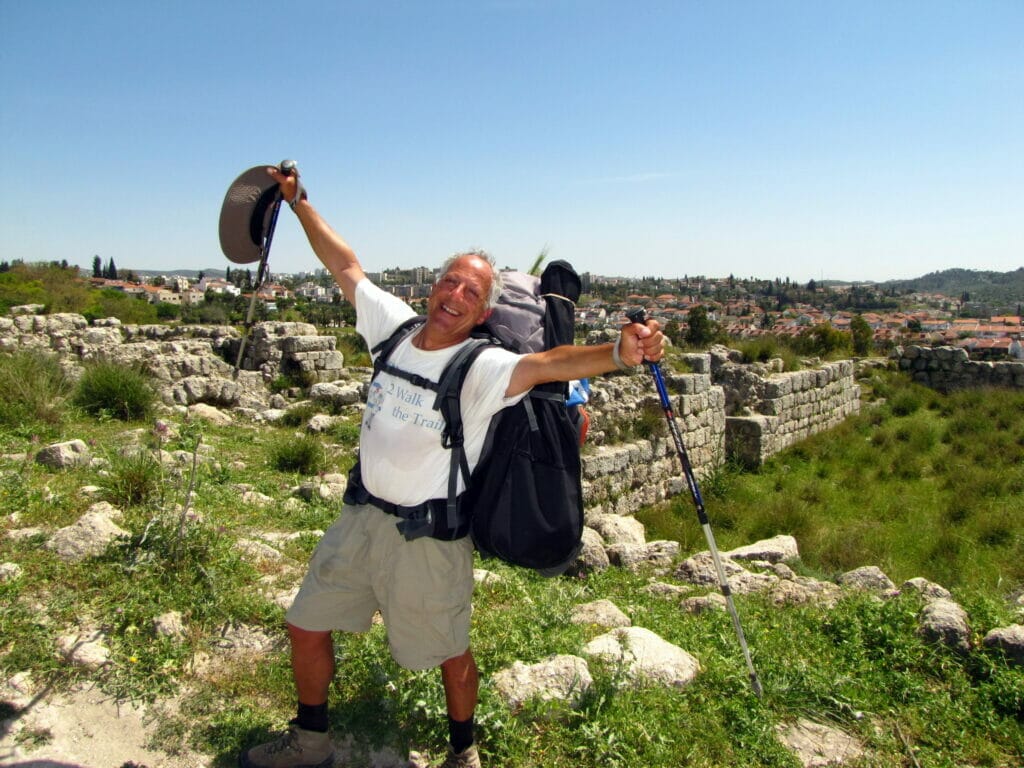
Susannah: Anything else you want to tell our readers about your experience?
Aryeh: If you can, do it! The overall experience, the challenge and the achievement, are incomparable. But do know that it’s possible to spend a half-day, even just a few hours, on the Trail, which can add an exquisite facet to any visit to Israel (or to any day spent here for an Israeli). As just one example, so many visitors to Jerusalem do ‘the usual’; but in two hours you can visit Sataf, in the hills just west of the city, a unique reconstruction of biblical-era stepped agricultural terraces, replete with ancient buildings and caves and springs you can even swim in. Just do it!
Susannah: Where can readers go to find out more about the book?
Aryeh: Our website is www.myisraeltrail.com. It’s available on Amazon and at Barnes & Noble, Target, CostCo, Walgreens and other outlets, and in Israel at Pomeranz in Jerusalem and most Steimatskys. Thanks!
Susannah: Thank you, Aryeh!



1 thought on “My Israel Trail: Finding Peace in Promised Land”